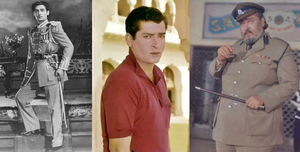
Can you imagine the dapper Dev Anand singing ‘Tumsa Nahin Dekha’, or yelling ‘Yahoo’ as he dares ‘Chahe Koi Mujhe Junglee Kahe’, or serenading the ‘O Haseena Zulfonwali’? All these films — ‘Tumsa Nahi Dekha’ (1957), ‘Junglee’ (1961), and ‘Teesri Manzil’ — were conceived for him but he rejected them for various reasons, paving the way for a new star.Shammi Kapoor filled the breach — and went on to create a new hero archetype and film genre of the pure entertainment musical romance.
After 18 successive flops and one average performance, he was ready to give up the Hindi film industry and become a tea plantation manager in Assam. However, a radical re-invention of his image, drawing on youth icons James Dean and Elvis Presley — though suitably indigenised, aided by Dev Anand’s triple reluctance, set him on the road to success.
A scion of the illustrious Kapoor family, films were an automatic choice for Shamsher Raj ‘Shammi’ Kapoor (1931-2011), who was born on this day (October 21) in Bombay. However, he did not find his initial going in the film world easy — most of the heroines considered him a ‘baccha’, having worked already with either his father, Prithviraj Kapoor or his elder brother, Raj Kapoor, and most filmmakers considered him a “clone” of his elder brother.
In the wake of his string of failures, whatever the genre — tragic and historical romances, comedies, thrillers or costumed dramas with top actresses like Suraiya, Madhubala, (future wife) Geeta Bali, and Meena Kumari across most of the 1950s, he understood that he needed to devise his own special, game-changing persona. Shammi Kapoor confessed, as per Rauf Ahmed’s biography that he never liked the existing model of the Hindi film hero, whom he felt was too submissive and defeatist and would give up the love of his life under paternal or family pressure and sing sad songs outside her house.
Circumstances made him the harbinger of change — a flamboyantly self-confident, outspoken, and even cocky, figure, with an easygoing approach to life, and not hesitating in enjoying it without hangups. It came as a refreshing foil to the meek persona, cultivated by Raj Kapoor, in his Chaplin-like tramp roles, or the brooding and tragic intensity of Dilip Kumar, and was way ahead of the jaunty Dev Anand, who could never reach that level of uninhibited exuberance.
Dev Anand’s rejection of ‘Tumsa Nahi Dekha’, where he termed the hero “not his type”, as well as the other films, gave Shammi Kapoor the opportunity and he did not let it for over a decade. However, in a gentlemanly gesture, when approached for these roles, he reached out to Dev Anand and confirmed his denial before accepting.
Shammi Kapoor proved that ‘Tumsa Nahi Dekhha’ was no fluke, with ‘Dil Deke Dekho’ (1959), and then ‘Junglee’ (1961) — where his full-throated ‘Yahoo’ became iconic (incidentally, neither the actor nor singer Mohammad Rafi, but writer and later director Prayag Raj yelled it out).
‘Professor’, ‘China Town’ (both 1962), ‘Bluff Master’ (1963), ‘Rajkumar’, ‘Kashmir Ki Kali’ (1964), ‘Janwar’ (1965) — where not only did ‘Dekho Ab To Kisi Ko Nahi Hai Khabar’ reprise the tune of the Beatles’ ‘I Wanna Hold Your Hand’ but also had a set of Indian Beatles impersonators belt it out, ‘Budtameez’ (1966), ‘An Evening in Paris’ (1967), ‘Brahmachari’ (1968), ‘Tumse Achha Kaun Hai’, and ‘Prince’ (both 1969) went to mark his legacy in the Indian films pantheon, with his dancing and emoting.
In the process, Shammi Kapoor became a gold standard for the dancing Bollywood hero, with several generations spanning Jeetendra, Rajesh Khanna, Amitabh Bachchan, Mithun Chakraborty, Govinda, Shah Rukh Khan, and his own great-grand-nephew Ranbir Kapoor, following in his footsteps, or rather, jives
However, after an over-decade-long reign as the jiving romantic hero — with all his dancing self-choreographed, he gauged that it was time to yield to the new generation, especially after ‘Andaz’ (1971), where Rajesh Khanna stole the show with his 15-minute cameo — including ‘Zindagi Ek Safar Hai Suhana’ over his more nuanced role.
A bulkier and bearded Shammi Kapoor switched to mature character roles like tavern-owner Dhoop Chaaon in ‘Manoranjan’ (1974) — the remake of Shirley MacLaine’s ‘Irma La Douce’ he directed himself, Amitabh Bachchan and Vinod Khanna’s foster-father in ‘Parvarish’ (1977), the fake holy man, Dr Dubari in ‘Shalimar’ (1978), the Sisodia Maharaja in ‘Meera’ (1979), the dance judge in Sanjay Dutt’s debut ‘Rocky’ (1981), engine driver — and Dilip Kumar’s colleague — Gurbaksh in ‘Vidhaata’ (1982), down to the music ustad in his great-grand-nephew Ranbir Kapoor’s ‘Rockstar’ (2011) – released a couple of months after his demise.
As a biography of the Kapoor family held, his elder brother had founded an institution, but Shammi Kapoor became one himself, as Bollywood’s most irrepressible prototype of the “Swinging Sixties”.
Recent Random Post:
















